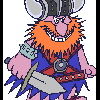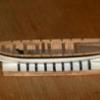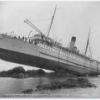HOLIDAY DONATION DRIVE - SUPPORT MSW - DO YOUR PART TO KEEP THIS GREAT FORUM GOING!
×
-
Posts
693 -
Joined
-
Last visited
Reputation Activity
-
 rvchima got a reaction from JPett in USS Arleigh Burke by rvchima - FINISHED - BlueJacket Shipcrafters - 1/16" scale - guided missile destroyer
rvchima got a reaction from JPett in USS Arleigh Burke by rvchima - FINISHED - BlueJacket Shipcrafters - 1/16" scale - guided missile destroyer
Mast Construction, 32 days, 90 hours
The mast is made from 1/4" square basswood set on the diagonal and swept back 15 degrees. The yards are photo-etched brass reinforced with 1/16" square brass tubes glued with CA.
The yard braces are made from 1/32" square brass stock. The instructions said to glue these pieces together, but when it was time to sand them flush they just broke off. Instead I soldered the main joint with long pieces, cut the braces slightly long with wire cutters, then sanded everything flush on a Proxxon disk sander. My other hobby is stained glass so I've done a lot of soldering.
It was hard to hold the mast in my vise because it is set on the diagonal, so I chopped a square hole in a piece of poplar to make a holder.
To make the platform braces I spun the brass stock against the sander to make a point that I shoved into the mast. I clipped the other end slightly long, sanded the end to match the platform, and glued both ends with CA. They are super strong.
The mast has a zillion tiny photo-etched pieces. I put on my magnifying headset and started snipping, filing, and gluing. The 8 little antennas on the top mast extension are about the size of a grain of rice and were especially hard. It's good that the kit includes lots of spares because several pieces went flying, never to be seen again. The two radar antennas are cast pieces.
The mast took about 20 hours to build. It was challenging but actually a lot of fun, and it looks beautiful.
-
 rvchima got a reaction from GuntherMT in USS Arleigh Burke by rvchima - FINISHED - BlueJacket Shipcrafters - 1/16" scale - guided missile destroyer
rvchima got a reaction from GuntherMT in USS Arleigh Burke by rvchima - FINISHED - BlueJacket Shipcrafters - 1/16" scale - guided missile destroyer
Jud,
Thanks for posting the photo of the USS Ammen. The prop shafts appear identical to the Arleigh-Burke, but the Ammen props have 3 blades while the A-B props have 5. (see below.)
The props in the kit have a metal hub and photo-etched brass blades. I haven't built them yet but they didn't seem nice enough, so I ordered a pair of of 25mm cast props from http://www.model-dockyard.com/. I'll decide what to use when they come.
-
 rvchima got a reaction from gerrynash in USS Arleigh Burke by rvchima - FINISHED - BlueJacket Shipcrafters - 1/16" scale - guided missile destroyer
rvchima got a reaction from gerrynash in USS Arleigh Burke by rvchima - FINISHED - BlueJacket Shipcrafters - 1/16" scale - guided missile destroyer
US Naval Academy Museum, Annapolis MD
Last weekend my wife Cinda Williams Chima and I went to the Baltimore Bookfest. She writes fantasy novels for young adults. I took a day off and visited the US Naval Academy Museum in Annapolis, MD. The first floor of the museum has a history of the US Navy with plenty of ship models. The second floor houses the Rogers Ship Model Collection with 108 ship models from 1650 to 1850.
Azzoun gave a great description of the museum on MSW back in 2014, so I won't repeat everything here. I'll just state that this was one of the most amazing collection of ship models that I've ever seen. It made me want to go home and try harder. This spectacular model of the USS Maury might give you an idea what I'm talking about.
-
 rvchima got a reaction from hexnut in USS Arleigh Burke by rvchima - FINISHED - BlueJacket Shipcrafters - 1/16" scale - guided missile destroyer
rvchima got a reaction from hexnut in USS Arleigh Burke by rvchima - FINISHED - BlueJacket Shipcrafters - 1/16" scale - guided missile destroyer
Jud,
Thanks for posting the photo of the USS Ammen. The prop shafts appear identical to the Arleigh-Burke, but the Ammen props have 3 blades while the A-B props have 5. (see below.)
The props in the kit have a metal hub and photo-etched brass blades. I haven't built them yet but they didn't seem nice enough, so I ordered a pair of of 25mm cast props from http://www.model-dockyard.com/. I'll decide what to use when they come.
-
 rvchima got a reaction from JPett in USS Arleigh Burke by rvchima - FINISHED - BlueJacket Shipcrafters - 1/16" scale - guided missile destroyer
rvchima got a reaction from JPett in USS Arleigh Burke by rvchima - FINISHED - BlueJacket Shipcrafters - 1/16" scale - guided missile destroyer
Progress, Frustration, and more Progress 4 days, 21 hours
The first step on the Arleigh Burke kit, cleaning up the hull, was easy. I trimmed off the attachment points freehand on the band saw, removed the rest with a gouge, and cleaned up everything with a palm sander. The hull shape was nearly perfect but I had to remove a little material aft to match the deck plan. The back step on the aft deck is cut square but should be sloped inward a few degrees. I cut that on a table saw.
Then the project became frustrating.
The cast resin prop shaft attachments were some of the worst cast pieces that I've ever seen. Not only were they full of pits, but they were covered with extraneous nubs and debris. Bluejacket should be embarrassed to include them in such a high-priced kit. I spent several hours sanding, filing, and filling and still was not happy with the result.
The prop shaft assembly consists of the resin attachment point, a flexible styrene shaft, and a cast pot-metal strut. The strut looked OK until I realized how soft the metal was. I could just imagine the flexible metal strut and flexible styrene shaft bending over the first time I bumped the model.
There is no indication on the plans as to where the strut attaches to the hull, whether it should be vertical or angled. A short search on-line showed that the Arleigh-Burke has two angled struts on each prop shaft. I gave up on the resin/styrene/pot-metal construction and built my own prop shafts.
My prop shafts are made out of brass tubing with wooden struts. I spun the egg-shaped bearings on my drill press and sanded them to shape. There are two struts on each shaft. One is nearly vertical and the other slopes inward to the hull center line. The whole assembly is rock solid and looks so much better than what came with the kit. The rudders were also cast resin and were flawless.
The sonar unit is contained in the bulbous bow of the ship that reduces wave drag. On the model the bulb is made of cast resin. It had a few pits but was usable. I had to carve the bow to get it to fit into the slot in the bulb. I still need to do some sanding on the filler at the edges.
The anchor chain will go through a hawse pipe drilled through the bow. The hole is lined with more styrene tube. I expected a cast metal fitting for the bow, but the instructions said to use a "suitable filler" to build my own. I used 5-minute epoxy putty that I rough-shaped by hand, then carved after it was solid. I guess it looks OK, but still another disappointment from an expensive kit.
-
 rvchima got a reaction from WackoWolf in USS Arleigh Burke by rvchima - FINISHED - BlueJacket Shipcrafters - 1/16" scale - guided missile destroyer
rvchima got a reaction from WackoWolf in USS Arleigh Burke by rvchima - FINISHED - BlueJacket Shipcrafters - 1/16" scale - guided missile destroyer
Great question, I've been wondering the same thing. Metal tools leave marks on the deck gray that I can't remove, so I would like to protect that with a top coat. Can anyone recommend a product that they like?
-
 rvchima got a reaction from Canute in USS Arleigh Burke by rvchima - FINISHED - BlueJacket Shipcrafters - 1/16" scale - guided missile destroyer
rvchima got a reaction from Canute in USS Arleigh Burke by rvchima - FINISHED - BlueJacket Shipcrafters - 1/16" scale - guided missile destroyer
Great question, I've been wondering the same thing. Metal tools leave marks on the deck gray that I can't remove, so I would like to protect that with a top coat. Can anyone recommend a product that they like?
-
 rvchima got a reaction from FriedClams in USS Arleigh Burke by rvchima - FINISHED - BlueJacket Shipcrafters - 1/16" scale - guided missile destroyer
rvchima got a reaction from FriedClams in USS Arleigh Burke by rvchima - FINISHED - BlueJacket Shipcrafters - 1/16" scale - guided missile destroyer
It's Not Done Yet
Lest you think that I'm almost done with this model, here's a photo of the parts that still need to be attached. Sigh...
-
 rvchima got a reaction from JPett in USS Arleigh Burke by rvchima - FINISHED - BlueJacket Shipcrafters - 1/16" scale - guided missile destroyer
rvchima got a reaction from JPett in USS Arleigh Burke by rvchima - FINISHED - BlueJacket Shipcrafters - 1/16" scale - guided missile destroyer
Painting 38 days, 120 hours
My previous post about pin striping tape turned out to be a moot question. I was ready to paint and my tape still had not arrived. I painted the top of the hull with Testors Haze gray, masked that off, painted the bottom with Rustoleum Colonial red, masked that off, and painted the waterline with Testors flat black. I kept a couple of samples going to make sure that everything was compatible. The results were perfect. No touch up necessary.
Then I masked the hull off and painted the deck with Testors Euro gray.
The kit comes with self-adhesive stencils for the Helicopter landing markings. They are a little tricky to apply because when you remove the backing everything flops loose. Nevertheless, they went down OK. I airbrushed maybe 6 light coats of flat white, using a hair dryer between coats.
Removing the stencils was pure terror. If I screwed up there was no recourse. But the results looked pretty good.
Here's everything stacked up so far. It's starting to look like a real ship!
-
 rvchima got a reaction from JPett in USS Arleigh Burke by rvchima - FINISHED - BlueJacket Shipcrafters - 1/16" scale - guided missile destroyer
rvchima got a reaction from JPett in USS Arleigh Burke by rvchima - FINISHED - BlueJacket Shipcrafters - 1/16" scale - guided missile destroyer
Harpoon Missile Racks
These Harpoon missile racks couldn't have been much harder to build. I spent about 9 hours on the two of them. Each rack has 28 pieces:
6 photo-etched brass frames laminated into 3 double pieces. 4 cast metal tubes that don't fit in the frames without sanding. 2 pieces of brass wire along the bottom. 3 tiny photo-etched brass struts on the bottom. 8 brass pieces for the legs. I glued these together with CA. 1 styrene blast sheild. 4 cast metal feet. Does that add up to 28? I've lost count.
They do look pretty good when they're done.
-
 rvchima got a reaction from JPett in USS Arleigh Burke by rvchima - FINISHED - BlueJacket Shipcrafters - 1/16" scale - guided missile destroyer
rvchima got a reaction from JPett in USS Arleigh Burke by rvchima - FINISHED - BlueJacket Shipcrafters - 1/16" scale - guided missile destroyer
Masking tape model
I've seen ship models made of card, bone, and toothpicks, so I thought it would be fun to make one out of masking tape.
Ha ha, only joking. I REALLY did not want to mask off the entire forward superstructure to paint the decks, so I half-masked (half-assed) it and tried to paint it with a brush. I watched every boring video on Youtube about brush painting, and the results still weren't up to my generally low standards. So I bit the bullet and masked the hole thing off.
Here's the result after a little retouching. There is very little difference between the Haze gray walls and the Euro gray decks.
-
 rvchima got a reaction from Canute in USS Arleigh Burke by rvchima - FINISHED - BlueJacket Shipcrafters - 1/16" scale - guided missile destroyer
rvchima got a reaction from Canute in USS Arleigh Burke by rvchima - FINISHED - BlueJacket Shipcrafters - 1/16" scale - guided missile destroyer
Pin Striping Tape?
What do you all think of using pin striping tape for the waterline? I used it on my Amati U-boat and Panart Harbour tug. It looks good now but I worry that it will come off before I die and I'll have to fix it.
-
 rvchima got a reaction from Canute in USS Arleigh Burke by rvchima - FINISHED - BlueJacket Shipcrafters - 1/16" scale - guided missile destroyer
rvchima got a reaction from Canute in USS Arleigh Burke by rvchima - FINISHED - BlueJacket Shipcrafters - 1/16" scale - guided missile destroyer
Everything was fine until I put Krylon black over the Rustoleum. I'm back to that step but will try Testors black instead - on a test piece.
The Rustoleum Colonial red satin actually looks great.
-
 rvchima got a reaction from Canute in USS Arleigh Burke by rvchima - FINISHED - BlueJacket Shipcrafters - 1/16" scale - guided missile destroyer
rvchima got a reaction from Canute in USS Arleigh Burke by rvchima - FINISHED - BlueJacket Shipcrafters - 1/16" scale - guided missile destroyer
Oh Nooo!
Over the last couple of days I airbrushed Testors Haze gray above the waterline. I masked that off and sprayed Rustoleum Colonial red below. Last night I masked that off and sprayed the 1/4" waterline Krylon flat black. When I looked at it 1/2 hour later it was completely bubbled, crazed, and orange-peeled. I wish I had taken a photo to show just how bad it was, but instead I stayed up real late sanding everything off.
Today I filled a lot of gouges, primed, and basically started over with the Haze gray. I also ordered some 1/4" matte black chart tape for the waterline. I might still try to paint it, but with a different paint.
-
 rvchima got a reaction from JPett in USS Arleigh Burke by rvchima - FINISHED - BlueJacket Shipcrafters - 1/16" scale - guided missile destroyer
rvchima got a reaction from JPett in USS Arleigh Burke by rvchima - FINISHED - BlueJacket Shipcrafters - 1/16" scale - guided missile destroyer
Getting Ready to Paint
No need for a fancy jig to mark the waterline. So far I've sprayed the top of the hull Haze gray, masked that off, and sprayed a coat of red on bottom. Photos coming soon.
-
 rvchima got a reaction from JPett in USS Arleigh Burke by rvchima - FINISHED - BlueJacket Shipcrafters - 1/16" scale - guided missile destroyer
rvchima got a reaction from JPett in USS Arleigh Burke by rvchima - FINISHED - BlueJacket Shipcrafters - 1/16" scale - guided missile destroyer
Superstructure
I've added a lot of detail parts to the superstructure - extensions around the top of the stacks, ladders, antennas, etc. I painted everything Haze gray using the Testors paints that I bought with the kit, and a cheap Badger airbrush. The horizontal deck surfaces on the aft superstructure are painted Euro gray using a brush and a lot of masking tape.
Speaking of antennas, the two antennas on the front of the aft superstructure are cast metal pieces that are butt-glued to a photo-etched platform. Well I've broken the platform and antennas off more times than I can remember, so the other day I deconstructed everything, drilled two holes in the platform, glued it back with a 1/32" brace underneath, and epoxied the antennas in the holes. They aren't going anywhere now.
Then today when I went to take this photo I broke the single antenna off the front stack. Looks like more deconstruction ahead.
-
 rvchima got a reaction from GuntherMT in USS Arleigh Burke by rvchima - FINISHED - BlueJacket Shipcrafters - 1/16" scale - guided missile destroyer
rvchima got a reaction from GuntherMT in USS Arleigh Burke by rvchima - FINISHED - BlueJacket Shipcrafters - 1/16" scale - guided missile destroyer
Mast Construction, 32 days, 90 hours
The mast is made from 1/4" square basswood set on the diagonal and swept back 15 degrees. The yards are photo-etched brass reinforced with 1/16" square brass tubes glued with CA.
The yard braces are made from 1/32" square brass stock. The instructions said to glue these pieces together, but when it was time to sand them flush they just broke off. Instead I soldered the main joint with long pieces, cut the braces slightly long with wire cutters, then sanded everything flush on a Proxxon disk sander. My other hobby is stained glass so I've done a lot of soldering.
It was hard to hold the mast in my vise because it is set on the diagonal, so I chopped a square hole in a piece of poplar to make a holder.
To make the platform braces I spun the brass stock against the sander to make a point that I shoved into the mast. I clipped the other end slightly long, sanded the end to match the platform, and glued both ends with CA. They are super strong.
The mast has a zillion tiny photo-etched pieces. I put on my magnifying headset and started snipping, filing, and gluing. The 8 little antennas on the top mast extension are about the size of a grain of rice and were especially hard. It's good that the kit includes lots of spares because several pieces went flying, never to be seen again. The two radar antennas are cast pieces.
The mast took about 20 hours to build. It was challenging but actually a lot of fun, and it looks beautiful.
-
 rvchima got a reaction from JPett in USS Arleigh Burke by rvchima - FINISHED - BlueJacket Shipcrafters - 1/16" scale - guided missile destroyer
rvchima got a reaction from JPett in USS Arleigh Burke by rvchima - FINISHED - BlueJacket Shipcrafters - 1/16" scale - guided missile destroyer
Resin Parts
After my problems with the resin prop shaft pieces I decided to check all the resin parts. I discovered that one radar unit was missing and several parts had serious voids. I emailed Bluejacket and received a quick response from Nic. It took a couple of weeks to get the replacement parts, but I'm not ready for them yet anyway. The new parts look good.
-
 rvchima got a reaction from mtaylor in USS Arleigh Burke by rvchima - FINISHED - BlueJacket Shipcrafters - 1/16" scale - guided missile destroyer
rvchima got a reaction from mtaylor in USS Arleigh Burke by rvchima - FINISHED - BlueJacket Shipcrafters - 1/16" scale - guided missile destroyer
Great question, I've been wondering the same thing. Metal tools leave marks on the deck gray that I can't remove, so I would like to protect that with a top coat. Can anyone recommend a product that they like?
-
 rvchima got a reaction from Old Collingwood in USS Arleigh Burke by rvchima - FINISHED - BlueJacket Shipcrafters - 1/16" scale - guided missile destroyer
rvchima got a reaction from Old Collingwood in USS Arleigh Burke by rvchima - FINISHED - BlueJacket Shipcrafters - 1/16" scale - guided missile destroyer
Great question, I've been wondering the same thing. Metal tools leave marks on the deck gray that I can't remove, so I would like to protect that with a top coat. Can anyone recommend a product that they like?
-
 rvchima got a reaction from JPAM in USS Arleigh Burke by rvchima - FINISHED - BlueJacket Shipcrafters - 1/16" scale - guided missile destroyer
rvchima got a reaction from JPAM in USS Arleigh Burke by rvchima - FINISHED - BlueJacket Shipcrafters - 1/16" scale - guided missile destroyer
Painting 38 days, 120 hours
My previous post about pin striping tape turned out to be a moot question. I was ready to paint and my tape still had not arrived. I painted the top of the hull with Testors Haze gray, masked that off, painted the bottom with Rustoleum Colonial red, masked that off, and painted the waterline with Testors flat black. I kept a couple of samples going to make sure that everything was compatible. The results were perfect. No touch up necessary.
Then I masked the hull off and painted the deck with Testors Euro gray.
The kit comes with self-adhesive stencils for the Helicopter landing markings. They are a little tricky to apply because when you remove the backing everything flops loose. Nevertheless, they went down OK. I airbrushed maybe 6 light coats of flat white, using a hair dryer between coats.
Removing the stencils was pure terror. If I screwed up there was no recourse. But the results looked pretty good.
Here's everything stacked up so far. It's starting to look like a real ship!
-
 rvchima got a reaction from FriedClams in USS Arleigh Burke by rvchima - FINISHED - BlueJacket Shipcrafters - 1/16" scale - guided missile destroyer
rvchima got a reaction from FriedClams in USS Arleigh Burke by rvchima - FINISHED - BlueJacket Shipcrafters - 1/16" scale - guided missile destroyer
Harpoon Missile Racks
These Harpoon missile racks couldn't have been much harder to build. I spent about 9 hours on the two of them. Each rack has 28 pieces:
6 photo-etched brass frames laminated into 3 double pieces. 4 cast metal tubes that don't fit in the frames without sanding. 2 pieces of brass wire along the bottom. 3 tiny photo-etched brass struts on the bottom. 8 brass pieces for the legs. I glued these together with CA. 1 styrene blast sheild. 4 cast metal feet. Does that add up to 28? I've lost count.
They do look pretty good when they're done.
-
 rvchima got a reaction from schooner in USS Arleigh Burke by rvchima - FINISHED - BlueJacket Shipcrafters - 1/16" scale - guided missile destroyer
rvchima got a reaction from schooner in USS Arleigh Burke by rvchima - FINISHED - BlueJacket Shipcrafters - 1/16" scale - guided missile destroyer
It's Not Done Yet
Lest you think that I'm almost done with this model, here's a photo of the parts that still need to be attached. Sigh...
-
 rvchima got a reaction from schooner in USS Arleigh Burke by rvchima - FINISHED - BlueJacket Shipcrafters - 1/16" scale - guided missile destroyer
rvchima got a reaction from schooner in USS Arleigh Burke by rvchima - FINISHED - BlueJacket Shipcrafters - 1/16" scale - guided missile destroyer
Painting 38 days, 120 hours
My previous post about pin striping tape turned out to be a moot question. I was ready to paint and my tape still had not arrived. I painted the top of the hull with Testors Haze gray, masked that off, painted the bottom with Rustoleum Colonial red, masked that off, and painted the waterline with Testors flat black. I kept a couple of samples going to make sure that everything was compatible. The results were perfect. No touch up necessary.
Then I masked the hull off and painted the deck with Testors Euro gray.
The kit comes with self-adhesive stencils for the Helicopter landing markings. They are a little tricky to apply because when you remove the backing everything flops loose. Nevertheless, they went down OK. I airbrushed maybe 6 light coats of flat white, using a hair dryer between coats.
Removing the stencils was pure terror. If I screwed up there was no recourse. But the results looked pretty good.
Here's everything stacked up so far. It's starting to look like a real ship!
-
 rvchima got a reaction from schooner in USS Arleigh Burke by rvchima - FINISHED - BlueJacket Shipcrafters - 1/16" scale - guided missile destroyer
rvchima got a reaction from schooner in USS Arleigh Burke by rvchima - FINISHED - BlueJacket Shipcrafters - 1/16" scale - guided missile destroyer
Harpoon Missile Racks
These Harpoon missile racks couldn't have been much harder to build. I spent about 9 hours on the two of them. Each rack has 28 pieces:
6 photo-etched brass frames laminated into 3 double pieces. 4 cast metal tubes that don't fit in the frames without sanding. 2 pieces of brass wire along the bottom. 3 tiny photo-etched brass struts on the bottom. 8 brass pieces for the legs. I glued these together with CA. 1 styrene blast sheild. 4 cast metal feet. Does that add up to 28? I've lost count.
They do look pretty good when they're done.












